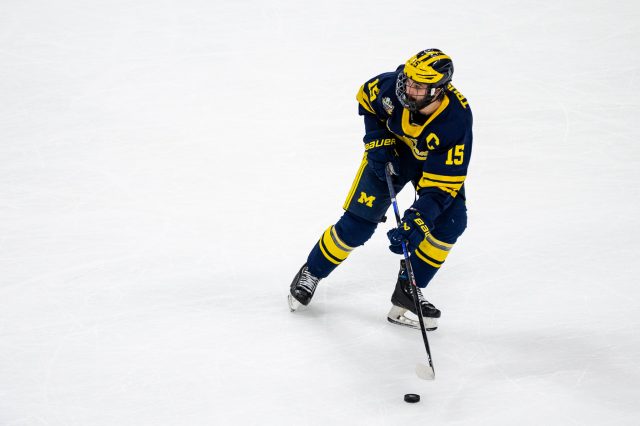[ad_1]
In hockey, a right-handed shot is more rare than a left-handed shot. Players tend to place their dominant hand near the top of their stick, therefore shooting and stickhandling on their non-dominant side.
Last season, the Michigan hockey team’s roster featured four defensemen with a right-handed shot, one of which was standout defenseman Seamus Casey. But this year’s seventh-ranked Wolverines have just two, freshman Hunter Hady and sophomore Josh Orrico.
With 6-to-7 defensemen seeing the ice per game, all of Michigan’s left-handed players will be forced into playing on their “wrong” side to give them experience outside of their comfort zone. While some may see this as a disadvantage, the Wolverines see it as an opportunity to make its defense more well-rounded.
“I think it’s good for development,” Michigan coach Brandon Naurato said Tuesday. “ … You don’t want to be at the next spot or even here and pigeonhole yourself by not being able to play both. So I think there’s a lot of development opportunity through us doing this, but it’s not by design. We just want to try to get the best players we can.”
Playing on the opposite side of the ice is an adjustment. When playing on the opposite side, defensemen have a blind side, meaning the outer lanes and opposing forwards have space without sticks clogging them up. Additionally, defensemen need to turn themselves to feel comfortable on the puck if it’s sent to them on the right side.
However, playing defense on the wrong side can also be a blessing in disguise. Left-handed players playing on the right can clog the slot on defensive plays, aiding their goaltender and blocking pucks from getting into the crease. They can also take their own shots with greater accuracy at the net front.
“You’re kind of one-sided,” graduate defenseman Jacob Truscott said. “You’ve got to open up your hips more when you get the puck on your right side. But I think you can use it to your advantage in the o-zone, being able to attack guys around the line. I think we can all learn from that. I think its a good skill for all of us to have.”
The Wolverines were extremely successful in playing left-handed defensemen on the right last season, specifically with former defenseman Marshall Warren. Prior to Michigan, Warren had never played on the right side, but in his one year as a Wolverine, he turned a perceived crutch into a big asset of his game.
Nowhere was this more clear than the NCAA Regional Final against Michigan State, where Warren’s left-handed shot on the right side gave Michigan the lead in a crucial moment. Left unmarked in the offensive zone, Warren waited for his opportunity to strike at the net front, to the right of goaltender Trey Augustine. With his stick on his left side, the puck found him, and then found the goal. Had Warren not trained to play on the right, that play could never have happened.
With Warren as a success story, this year’s Wolverines are following suit, learning to play on their non-dominant side. The majority of their defensemen have experience playing both sides, either under Naurato’s leadership or their previous teams. And while some have more experience than others, they’re all ready for the challenge.
“You have to learn different skills on that side and it definitely takes a little bit of time,” Truscott said. “But I think guys have been doing well with it. We’ve been switching on and off, everyone’s played the right side, left side or whatever it may be in this past month or so. So I think guys are getting comfortable with it, and I think it’ll be a good challenge for us.”
By not designating specific defensemen to play on the right side, instead opting for every defenseman to learn both, Naurato is preparing his players to be adaptable to any competition. And as the defensive pairings become solidified, it’s possible the ability to adapt to playing on their off-hand will be the deciding factor in who is in the lineup, and who is out.
Related articles
[ad_2]
Source link











